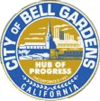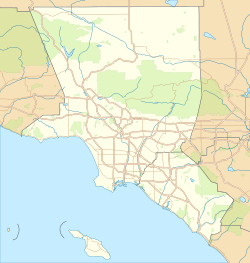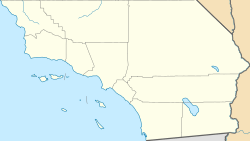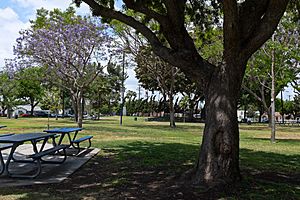Bell Gardens, California facts for kids
Quick facts for kids
Bell Gardens, California
|
|||
|---|---|---|---|
|
|||
| Motto(s):
Hub of Progress
|
|||
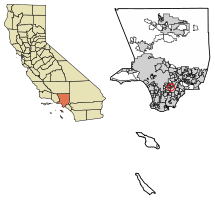
Location of Bell Gardens in Los Angeles County, California.
|
|||
| Country | United States | ||
| State | California | ||
| County | Los Angeles | ||
| Incorporated | August 1, 1961 | ||
| Government | |||
| • Type | Council-Manager government | ||
| • Body | Mayor Alejandra Cortez, Lisseth Flores (Mayor Pro Tem) Pedro Aceituno Marco Barcena |
||
| Area | |||
| • Total | 2.46 sq mi (6.38 km2) | ||
| • Land | 2.46 sq mi (6.37 km2) | ||
| • Water | 0.01 sq mi (0.01 km2) 0.18% | ||
| Elevation | 121 ft (37 m) | ||
| Population
(2020)
|
|||
| • Total | 39,501 | ||
| • Density | 16,063.85/sq mi (6,202.38/km2) | ||
| Time zone | UTC-8 (PST) | ||
| • Summer (DST) | UTC-7 (PDT) | ||
| ZIP Code |
90201, 90202
|
||
| Area code(s) | 213/323 | ||
| FIPS code | 06-04996 | ||
| GNIS feature IDs | 1660323, 2409817 | ||
Bell Gardens is a city in California, a state in the United States. It's located in Los Angeles County, which is part of the larger Los Angeles area. In 2020, about 39,501 people lived there.
Bell Gardens is special because it's one of only six cities in Los Angeles County where gambling casinos are allowed. It's also home to the oldest building in Los Angeles County!
The city got its name from James George Bell, a businessman. The "Gardens" part comes from the many Japanese immigrants who started vegetable and rice farms there a long time ago. The nearby city of Bell is also named after James George Bell.
Contents
History of Bell Gardens
The area where Bell Gardens is now has a long history, going back thousands of years to Native American times. Later, it became an important farming area. This was during the time of the Spanish Empire, then the Mexican government, and finally the United States after the Mexican-American War in 1848.
Early Spanish Settlers
One of the first Spanish families to settle here was the Lugo family. In 1810, Antonio Maria Lugo, a soldier, was given a huge piece of land called Rancho San Antonio. This was a reward for his military service. Today, this land includes Bell Gardens and many other cities like Bell, Maywood, and South Gate.
Antonio Lugo built several adobe homes (houses made of sun-dried clay bricks) on his land and raised cattle. One of these adobe houses, built in 1795, is still standing today at 7000 Gage Avenue. It's the oldest house in Los Angeles County! Antonio Lugo was even a Mayor of Los Angeles. He was known for riding magnificent horses and always speaking Spanish. He passed away in 1860 at 85 years old.
His son, Vicente Lugo, built another two-story adobe home in 1850. Later, in 1924, a colonial-style house was built at 6820 Foster Bridge Road. The original adobe house from 1795 was named Casa de Rancho San Antonio. When Henry T. Gage, a lawyer who married one of Lugo's granddaughters, lived there, he added more parts to the house and made it very fancy.
Farming and Growth
The first school in Bell Gardens, called San Antonio School, was built in 1867. It was one of the earliest schools in Los Angeles County.
Because the soil was so rich, many Japanese immigrants came to Bell Gardens. They leased land and grew high-quality vegetables and rice. Bell Gardens remained a farming community until the 1930s.
In 1927, the Firestone Tire Company bought some of the land. By 1900, the area was divided into smaller farms. The part next to the city of Bell became known as Bell Gardens. Around 1930, affordable homes were built for people during the Great Depression. During this time, the area was nicknamed 'Billy Goat Acres', and some people still call it that today!
World War I and World War II brought many defense factories to the area. This helped the economy grow and more people moved in. New homes, schools, and businesses were built.
Modern Bell Gardens
Bell Gardens is a relatively young city, officially becoming a city in 1961. Since then, its population has grown a lot. The city is quite diverse, with a large Hispanic population.
Today, Bell Gardens is a small city, but it still has a piece of the original Lugo land grant. The Casa Mobile home Park at 7000 Gage Ave. is on this land. In 1991, Lugo’s original home there was named State Historical Monument No. 984. This helps make sure that Antonio Maria Lugo's name and his historic home are saved for future generations.
Geography of Bell Gardens
Bell Gardens is located at 33°58′5″N 118°9′22″W / 33.96806°N 118.15611°W. It covers about 2.5 square miles (6.5 square kilometers), and almost all of it is land.
The city is surrounded by other cities:
- Bell and Cudahy are to the west.
- Commerce is to the north and northeast.
- Downey is to the southeast.
- South Gate is to the southwest.
Bell Gardens is about 10 miles (16 kilometers) southeast of Downtown Los Angeles.
Population and People
Bell Gardens has grown quite a bit over the years. Here's how the population has changed:
- 1960: 26,467 people
- 1970: 29,308 people
- 1980: 34,117 people
- 1990: 42,355 people
- 2000: 44,054 people
- 2010: 42,072 people
- 2020: 39,501 people
In 2020, the city's population was 39,501. Most people in Bell Gardens are of Hispanic or Latino background, making up over 96% of the population.
The average age in Bell Gardens is around 27 years old. Many families live in the city, and the average household has about 4 people.
Fun and Learning
Arts and Entertainment
Bell Gardens is home to The Bicycle Hotel & Casino, which is one of the biggest poker casinos in the world.
DEL Records, a company that works with Latin music artists, is also located in Bell Gardens.
Education
Most students in Bell Gardens go to schools in the Montebello Unified School District. This includes Bell Gardens High School.
A cool fact about Bell Gardens is that every public school there has an urban farm! These farms are run by students in the Environmental Garden Club, an after-school program.
City Services
Safety and Health
The Los Angeles County Fire Department helps keep Bell Gardens safe from fires. The Bell Gardens Police Department handles law enforcement and keeps the community secure.
For health services, the Los Angeles County Department of Health Services has a center in nearby Whittier that serves Bell Gardens residents.
Mail and Parks
The United States Postal Service has a post office in Bell Gardens on Garfield Ave.
The city also has 8 parks and one golf course, offering places for people to relax and play.
Famous People from Bell Gardens
Some notable people who have lived in Bell Gardens include:
- Tim Buckley, a musician
- Eddie Cochran, a musician
- John Force, a famous race car driver
- Ricardo Lara, a California politician
- Cristina Garcia, a California State Assembly member
See also
 In Spanish: Bell Gardens para niños
In Spanish: Bell Gardens para niños



